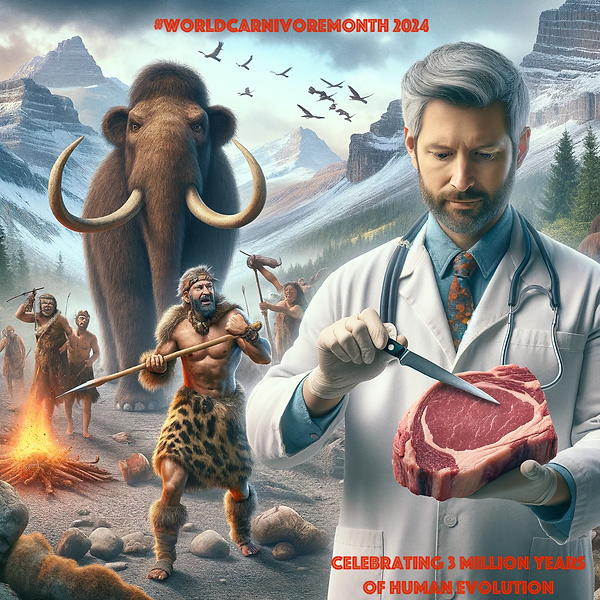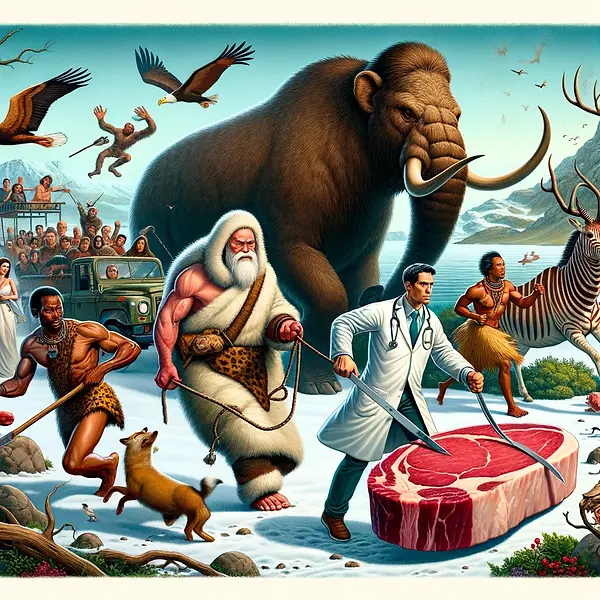


Title:
Caries related to hypocarnivory
Abstract:
Caries Through Time: An Anthropological Overview
Details
Although tooth plaque isn’t suitable for determining the HTL within the vast zooarchaeological landscape [53, 54], it may be marginally accurate for identifying shifts. For instance, Neanderthals were known to rely heavily on animal-sourced foods and only showed six caries (signs of decay) out of 1,250 of their teeth that were examined [55]. Caries started appearing in substantial numbers between 13,700 and 15,000 years ago in Morocco, alongside evidence of increased starch consumption [56]. The low occurrence of caries during most of the Pleistocene corresponds to a low carbohydrate, high HTL pattern.
Hard plant tissues do not contribute meaningfully to dental microwear: evolutionary implications
Abstract
Reconstructing diet is critical to understanding hominin adaptations. Isotopic and functional morphological analyses of early hominins are compatible with consumption of hard foods, such as mechanically-protected seeds, but dental microwear analyses are not. The protective shells surrounding seeds are thought to induce complex enamel surface textures characterized by heavy pitting, but these are absent on the teeth of most early hominins. Here we report nanowear experiments showing that the hardest woody shells – the hardest tissues made by dicotyledonous plants – cause very minor damage to enamel but are themselves heavily abraded (worn) in the process. Thus, hard plant tissues do not regularly create pits on enamel surfaces despite high forces clearly being associated with their oral processing. We conclude that hard plant tissues barely influence microwear textures and the exploitation of seeds from graminoid plants such as grasses and sedges could have formed a critical element in the dietary ecology of hominins.
Abstract
Non-occlusal, buccal tooth microwear variability has been studied in 68 fossil humans from Europe and the Near East. The microwear patterns observed suggest that a major shift in human dietary habits and food processing techniques might have taken place in the transition from the Middle to the Late Pleistocene populations. Differences in microwear density, average length, and orientation of striations indicate that Middle Pleistocene humans had more abrasive dietary habits than Late Pleistocene populations. Both dietary and cultural factors might be responsible for the differences observed. In addition, the Middle Paleolithic Neanderthal specimens studied show a highly heterogeneous pattern of microwear when compared to the other samples considered, which is inconsistent with a hypothesis of all Neanderthals having a strictly carnivorous diet. The high density of striations observed in the buccal surfaces of several Neanderthal teeth might be indicative of the inclusion of plant foods in their diet. The buccal microwear variability observed in the Neanderthals is compatible with an overall exploitation of both plant and meat foods on the basis of food availability. A preliminary analysis of the relationship between buccal microwear density and climatic conditions prevailing in Europe during the Late Pleistocene has been attempted. Cold climatic conditions, as indicated by oxygen isotope stage data, seem to be responsible for higher densities of microwear features, whereas warmer periods could correspond to a reduced pattern of scratch density. Such a relationship would be indicative of less abrasive dietary habits, perhaps more meat dependent, during warmer periods.
Caries Through Time: An Anthropological Overview
Bioanthropological researches carried out in the last few decades have given special emphasis to the study of the relation between disease, as well as social and environmental phenomena, enhancing the already strong connection between lifestyle and health conditions during history of humankind (Cohen & Armelagos, 1984; Katzenberg & Saunders, 2008; Larsen, 1997). Because infectious diseases result from the interaction between host and agent, modulated by ecological and cultural environments, the comparative study of the historic prevalence of diseases in past populations worldwide can provide important data about their related factors and etiology. The study of dental diseases (such as caries) has been given special attention from Paleopathology2. The tooth, for its physical features tends to resist destruction and taphonomic conditions better than any other body tissue and therefore, is a valuable element for the study on individual’s diet, and social and cultural factors related to it, from a population perspective. Caries is one of the infectious diseases more easily observable in human remains retrieved from archaeological excavations. For their long time of development and non-lethal nature the lesions presented at the time of the death remain recognizable indefinitely, allowing to infer, along with other archaeological and ecological data, the types of food that a specific population consumed, the cooking technology they used, the relative frequency of consumption, and the way the food was shared among the group (Hillson, 2001 2008; Larsen, 1997; Rodríguez, 2003).
Significance
We present early evidence linking a high prevalence of caries to a reliance on highly cariogenic wild plant foods in Pleistocene hunter-gatherers from North Africa. This evidence predates other high caries populations and the first signs of food production by several thousand years. We infer that increased reliance on wild plants rich in fermentable carbohydrates caused an early shift toward a disease-associated oral microbiota. Systematic harvesting and processing of wild food resources supported a more sedentary lifestyle during the Iberomaurusian than previously recognized. This research challenges commonly held assumptions that high rates of caries are indicative of agricultural societies.
Hypothesis:




